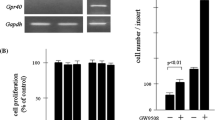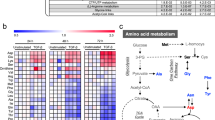Abstract
Lysophosphatidic acid (LPA) receptors (LPA1 to LPA6) indicate a variety of cellular responses, such as cell proliferation, migration, differentiation, and morphogenesis. However, the role of each LPA receptor is not functionally equivalent. Ethionine, an ethyl analog of methionine, is well known to be one of the potent liver carcinogens in rats. In this study, to assess whether ethionine may regulate cell motile activity through LPA receptors, rat liver epithelial (WB-F344) cells were treated with ethionine for 48 h. In cell motility assay with a cell culture insert, the treatment of ethionine at 1.0 and 10 μM enhanced significantly high cell motile activity, compared with untreated cells. The expression levels of LPA receptor genes in cells treated with ethionine were measured by quantitative real time RT-PCR analysis. The expression of the Lpar3 gene in ethionine-treated cells was significantly higher than that in untreated cells. Furthermore, to confirm an involvement of LPA3 on cell motility increased by ethionine, the Lpar3 knockdown cells were also used. The cell motile activity by ethionine was completely suppressed in the Lpar3 knockdown cells. These results suggest that LPA signaling through LPA3 may be involved in cell motile activity stimulated by ethionine in WB-F344 cells.




Similar content being viewed by others
Abbreviations
- LPA:
-
Lysophosphatidic acid
- LPA3 :
-
LPA receptor-3
- RT:
-
Reverse transcription
- PCR:
-
Polymerase chain reaction
References
Aoki J, Inoue A, Okudaira S (2008) Two pathways for lysophosphatidic acid production. Biochim Biophys Acta 1781:513–518
Fukushima N, Ishii I, Contos JA, Weiner JA, Chun J (2001) Lysophospholipid receptors. Annu Rev Pharmacol Toxicol 41:507–534
Ishii I, Fukushima N, Ye X, Chun J (2004) Lysophospholipid receptors: signaling and biology. Annu Rev Biochem 73:321–354
Lin M-E, Herr DR, Chun J (2010) Lysophosphatidic acid (LPA) receptors: signaling properties and disease relevance. Prostaglandins Other Lipid Mediat 91:130–138
Noguchi K, Herr D, Mutoh T, Chun J (2009) Lysophosphatidic acid (LPA) and its receptors. Curr Opin Pharmacol 9:15–23
Ishii S, Noguchi K, Yanagida K (2009) Non-Edg family lysophosphatidic acid (LPA) receptors. Prostaglandins Other Lipid Mediat 89:57–65
Yu S, Murph MM, Lu Y, Liu S, Hall HS, Liu J, Stephens C, Fang X, GMills GB (2008) Lysophosphatidic acid receptors determine tumorigenicity and aggressiveness of ovarian cancer cells. J Natl Cancer Inst 100:1630–1642
Okabe K, Hayashi M, Kato K, Okumura M, Fukui R, Honoki K, Fukushima F, Tsujiuchi (2013) Lysophosphatidic acid receptor-3 increases tumorigenicity and aggressiveness of rat hepatoma RH7777 cells. Mol Carcinog 52:247–254
Hayashi M, Okabe K, Kato K, Okumura M, Fukui R, Honoki K, Fukushima N, Tsujiuchi T (2012) Differential function of lysophosphatidic acid receptors in cell proliferation and migration of neuroblastoma cells. Cancer Lett 316:91–96
Hayashi M, Okabe K, Yamawaki Y, Teranishi M, Honoki K, Mori T, Fukushima F, Tsujiuchi T (2011) Loss of lysophosphatidic acid receptor-3 enhances cell migration in rat lung tumor cells. Biochem Biophys Res Commun 405:450–454
Farber E (1963) Ethionine carcinogenesis. Adv Cancer Rev 7:383–474
Okabe K, Kato K, Teranishi M, Okumura M, Fukui R, Mori T, Fukushima F, Tsujiuchi T (2011) Induction of lysophosphatidic acid receptor-3 by 12-O-tetradecanoylphorbol-13-acetate stimulates cell migration of rat liver cells. Cancer Lett 309:236–242
Shibata A, Tanabe E, Inoue S, Kitayoshi M, Okimoto S, Hirane M, Araki M, Fukushima N, Tsujiuchi T (2013) Hydrogen peroxide stimulates cell motile activity through LPA receptor-3 in liver epithelial WB-F344 cell. Biochem Biophys Res Commun 433:317–321
Tanabe E, Shibata A, Inoue S, Kitayoshi M, Fukushima N, Tsujiuchi T (2012) Regulation of cell motile activity through the different induction of LPA receptors by estrogens in liver epithelial WB-F344 cells. Biochem Biophys Res Commun 428:105–109
Shano S, Hatanaka K, Ninose S, Moriyama R, Tsujiuchi T, Fukushima N (2008) A lysophosphatidic acid receptor lacking the PDZ-binding domain is constitutively active and stimulates cell proliferation. Biochim Biophys Acta 1783:748–759
Furuta D, Yamane M, Tsujiuchi T, Moriyama R, Fukushima N (2012) Lysophosphatidic acid induces neurite branch formation through LPA3. Mol Cell Neurosci 50:21–34
Veal EA, Day AM, Morgan BA (2007) Hydrogen peroxide sensing and signaling. Mol Cell 26:1–14
Giretti MS, Simoncini T (2008) Rapid regulatory actions of sex steroids on cell movement through the actin cytoskeleton. Steroids 73:895–900
Fischer DJ, Nusser N, Virag T, Yokoyama K, Wang D-A, Baker, DL Bautista D, Parrill AL, Tigyi G (2001). Short-chain phosphatidates are subtype-selective antagonists of lysophosphatidic acid receptors. Mol Pharmacol 60:776–784
Tsujiuchi T, Kobayashi E, Nakae D, Mizumoto Y, Andoh N, Kitada H, Ohashi K, Fukuda T, Kido A, Tsutsumi M, Denda A, Konishi Y (1995) Prevention by methionine of hepatocarcinogenesis by coadministration of a choline-deficient l-amino acid defined diet and ethionine in rats. Jpn J Cancer Res 86:1136–1142
Tsujiuchi T, Yeleswarapu L, Konishi Y, Lombardi B (1997) Hot-spot mutations in p53 gene of liver nodules induced in rats fed dl-ethionine with a methyl-deficient diet. Br J Cancer 76:15–20
Okabe K, Hayashi M, Yoshida I, Nishimura K, Fukushima N, Tsujiuchi T (2011) Distinct DNA methylation patterns of lysophosphatidic acid receptor genes during rat hepatocarcinogenesis induced by a choline deficient l-amino acid defined diet. Arch Toxicol 85:1303–1310
Acknowledgments
This study was supported in part by a Grant-in-Aid (24590493) for Scientific Research (C) from Ministry of Education, Culture, Sports, Science and Technology, Japan, and by Grants from the Ministry of Health, Labor and Welfare of Japan.
Conflict of interest
The authors declare that they have no conflict of interest.
Author information
Authors and Affiliations
Corresponding author
Rights and permissions
About this article
Cite this article
Inoue, S., Tanabe, E., Shibata, A. et al. Ethionine regulates cell motile activity through LPA receptor-3 in liver epithelial WB-F344 cells. Mol Cell Biochem 383, 173–177 (2013). https://doi.org/10.1007/s11010-013-1765-9
Received:
Accepted:
Published:
Issue Date:
DOI: https://doi.org/10.1007/s11010-013-1765-9




